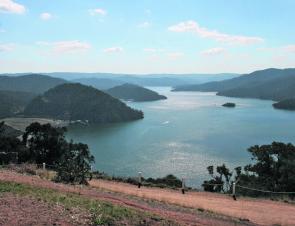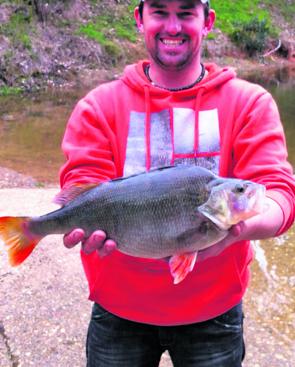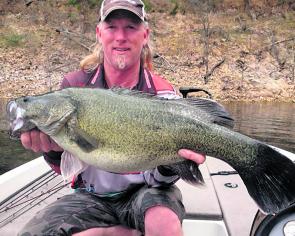Eildon is located about 140km northeast of Melbourne and is one of Australia’s most popular freshwater fishing destinations. Its healthy population of brown trout, rainbow trout, redfin, golden perch, Murray cod, roach, tench, and carp are a serious drawcard for anglers of various skills.
You can fish Lake Eildon year round but its rivers and streams are closed for trout fishing during winter. The Snobs Creek Hatchery regularly stocks the pondage with trout and the fishing is set to explode over the next few years.
It is a very popular holiday destination for ‘Melbournites’ as it is merely a 2-hour drive from the city. It has plenty of accommodation and attractions to suit ever member of the family. It has everything from wildlife walks to dirt bike tracks, boat hire to Lions Leisure Park, and the Freshwater Snobs Creek Discovery Centre will keep the little ones entertained for an afternoon.
Lake Eildon has a shoreline of almost 600km when at full supply and up to 30,000 people per day can be on the lake fishing, boating and doing watersports during summer.
Whether you’ve never visited before or just want to improve your catch rate, below is a guide to getting the most out of fishing the lake for its top species.
Lake Eildon has a large population of trout with fish spawning naturally in all of Eildon’s tributaries; the Delatite, Howqua, Upper Goulburn and Big rivers. It also has a fantastically managed stocking program from our friends at fisheries, who do an incredible job with this lake in particular. It also has a monstrous amount of redfin (English perch) to target and they are the best freshwater eating fish on offer.
The most productive method for fishing Lake Eildon for trout is trolling. Start off with a 2-3 rod spread and troll the steep bank with a flat-line Tassie Devil on the bank side, and a small size StumpJumper in the middle and a deep diving hardbody on the out side.
The best colours for the Tassie Devil are pink, the clown pattern, rainbow trout, traffic light and the frog pattern. For the StumpJumpers I would tend to use a mixture of bright colours with black in the pattern. I would use deep diving Cranka minnows in the golden trout or fire trout colours. Similar style lures around the 60-70mm will also do the job.
This technique also works extremely well on tree edges 20-30m off the bank. A sounder is very helpful to troll over submerged treetops without getting snagged every 10 seconds.
Casting edges can also be a productive method. Casting parallel to the bank is the best way to cover more water. Soft plastics like the Berkley 2 1/2” black and gold t-tail or Squidgy in Gary Glitter are the standouts, as they look just like the native galaxia in the lake. Suspending hardbodies from 40-80mm are also great for this method, once again Crankas, Rapalas, Daiwa Double Clutches, and small StumpJumpers (floating) are ideal.
Bait fishing for trout and redfin is extremely productive. The method is the same as the lures, with the only difference is that you would generally fish deeper (around 15m) for redfin. A simple size 1 hook and a small ball sinker straight to the hook is perfect. The best baits are scrub worms, small yabbies, Powerbait nuggets, dough or a mud-eye, if you have a few of these you can't go wrong.
As a general rule, the reddies congregate at the base of trees and the schools move about very quickly. Once you find a school keep a bait at the school at all times to keep them active.
Trout hot spots: The top of Big River, Goulburn arm, Howqua River, Main Arm Fraser Park
Redfin hot spots: Brankeet, the Pines, Fraser Park, Wool Shed, Italian Bay
Lake Eildon is fast becoming Victoria’s go-to spot for this awesome native fish with this year producing some mammoth 20lb females, which are just incredible to see, not to mention massive numbers of schooling males following the girls around in summer. Most of the yellas are stocked by fisheries and it just goes to show how successful their program is – top work Fisheries!
For first timers fishing for yellas it can be quite daunting, however, a great starting point is to troll. When you don't know a waterway the best method of finding fish is covering as much water as you can. By trolling and using your sounder you can cover a lot more water than casting or bait fishing, and this is the key with yellas. Once you have found them it opens up the door to try various other styles of fishing that may be more your style.
Trolling for yellas, fish in between 20-30ft of water using the ever-reliable StumpJumper or an Oar-Gee style lure that dives to about 20’, which will keep you in the strike zone. Most of the time, if you sound them up deeper just change your depth accordingly.
Colour of lure is a personal choice but blacks/purples, yellow/green, chartreuse/whites tend to work well. I firmly believe that if the fish are feeding, they will eat any colour in front of them but when they are a bit timid you may need to find the right colour to tempt them.
Once you have located the fish it's time to start changing things up a bit by casting lures. The best style of lure for casting at fish on rocky bottoms are lipless crankbaits like Jackall TN60’s, Mazzy vibes, Balista Juggernauts or Strike Pro Vibro 60’s and 75’s. When fishing these lures, it's important to fish as slow as you can. When you think you’re fishing slow go even slower – let them sit on the bottom with short hops all the way back to you pausing for 5-10 even 20 seconds between hops and they will play the game.
Suspending hardbodies that dive deep enough to where the fish are holding are also super effective. Cast one out in front of their faces and just let it sit there, it drives them mad until they just have to eat it. Even longer pauses up to 30 seconds, the same as fishing for black bream really.
Spinnerbaits are also very effective on yellas. Again work the lure very slowly and try and follow the depth contours of where you are fishing or target the abundant structure around the lake. When the fish are really slow, then go finesse with a soft plastic about 50mm on a super light jighead about 1/24oz and work it painfully slow. Your patience will be rewarded.
Bait fishing for yellas is quite one dimensional in Eildon, a 1/0 hook with a scrubbie or two on it or a yabby with a small ball sinker to the hook is all you need. Drop the bait at the base of trees in 30-40ft of water and it's dynamite.
Hot spots for golden perch early spring: between Ford Inlet and Brankeet on the northern shores, the mouth of the Delatite arm above Bonnie Doon Bridge.
Hot spots for golden perch summer: the dam wall and main arm fish, Big River arm and Goughs Bay.
Over the next 10 years, Lake Eildon will become Victoria’s premier cod fishery. There have been well over a million cod released into the system over the last 5 years and, with their astounding growth rate from the abundance of food in this very healthy lake, it's only a matter of time before the fishing explodes.
Trolling is a very productive way to fish here but there is such a vast amount of structure and differing depths that it can become a bit confusing. For early morning trolling, concentrate on depths between 10-20ft, when the sun comes up drop deeper into about 20-40ft, particularly when the water is like gin. Don't be scared to vary the size of your lures, from 60mm all the way up to 180-200mm. Large Oar-Gees, Codgers, StumpJumpers, Dynos or any deep diving barra style lures will go well. Once again, colour is a thing you must adapt to yourself but change it up until you find one that works for you.
Don't be scared to troll the same bank half a dozen times. If you sound up a fish it might just make it angry enough to strike out of aggression rather than just feeding. Pretty much every bank with fallen or standing structure on it has a chance of holding a quality fish. There are plenty of them in there, believe me!
For those of you who haven't fished for cod at all, cod don't school up like the yellas, they tend to be more territorial. When they start to try and spawn they will pair up so sometimes if you go back over the same spot you often get the other fish as well.
When casting for cod, which is my favourite way to catch them, you have many lure options to choose from. Spinnerbaits are a go-to lure in Eildon, but you must have a few heavy models (at least 1 1/2oz or so) because you might find yourself fishing in 40-50ft of water and a light lure will take too long to get into the strike zone, especially if it's windy.
Once again cast to banks early and late, then fish deeper throughout the middle of the day, particularly when it's bright sunshine. There are a lot of laydowns on the banks so make sure you fish all the way down to the bottom and the results will follow.
Lipless crankbaits are deadly on cod, my biggest to date a 40lb cod ate a TN50 Jackall, which proves lures don't have to be big. The lures that you use for trolling are also ideal to cast at trees and stumps and are great when the fish are holding closer to the surface.
Bait is also productive on cod and a bardi grub is the best bait by far. Worms and yabbies do well and cheese (yes cheese) can also produce great results. There are a lot of people that believe the cheese can kill the fish down the track because it can't digest it, but I have seen no evidence to support it. Nevertheless, if you’re worried don't risk it and just use the above baits.
Hot spots for cod: Main Arm, Point Shaw, Big River, Delatite, Brankeet and anywhere else with decent structure.
Reads: 6623
Lake Eildon has a picturesque landscape and is a fishing haven to suit all levels of anglers.

Redfin are a fantastic eating fish and they are abundant in the lake.

The banks of the lake hold a multitude of fish. Target your fishing around these areas.

Cod don't school up like the yellas they tend to be more territorial. You’ll find them skulking under logs and similar structure.




